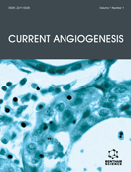Abstract
Angiogenesis describes the sprouting of new blood vessels from preexisting vascular networks. A tightly regulated balance between pro- and antiangiogenic factors regulates this process, which can be disrupted under pathological conditions. Tumor development is characterized by an “angiogenic switch”, which results in an increase in expression of pro-angiogenic factors such as vascular endothelial growth factor (VEGF) and concomitant repression of angiogenesis inhibitors such as thrombospondin- 1 (TSP-1). Overexpression of pro-angiogenic factors promotes the rapid formation of tumor vasculature, which typically is hyperpermeable, convoluted, and lacks normal perivascular cell interactions. This disorganized vasculature results in reduced tumor perfusion, which can significantly impair drug delivery to the tumor. Ovarian cancer is typically not detected until late stage and can present a therapeutic challenge, due to the presence of a large, poorly-vascularized tumor. The prevalence of chemoresistance in ovarian cancer has spurred recent research into alternative therapeutic targets for this disease. Various anti-angiogenic approaches have been studied, including targeting VEGF expression and restoring expression of anti-angiogenic factors such as TSP-1. Studies using anti-angiogenic treatments have demonstrated the preferential destruction of immature, dysfunctional blood vessels, with the preservation of healthy, parental vasculature. The vessel normalization induced by anti-angiogenic therapy has been found to improve tumor perfusion, facilitate uptake of chemotherapeutic compounds and is associated with tumor regression even in advanced stage ovarian cancer. The purpose of this review is to examine the pathological angiogenic processes that characterize tumor growth, evaluate the efficacy of anti-angiogenic therapies, and discuss the process and therapeutic implications of vessel normalization in the context of antiangiogenic therapies for advanced stage ovarian cancer.
Keywords: Angiogenesis inhibitors, thrombospondin, anti-cancer therapy, combination therapy.
 20
20

